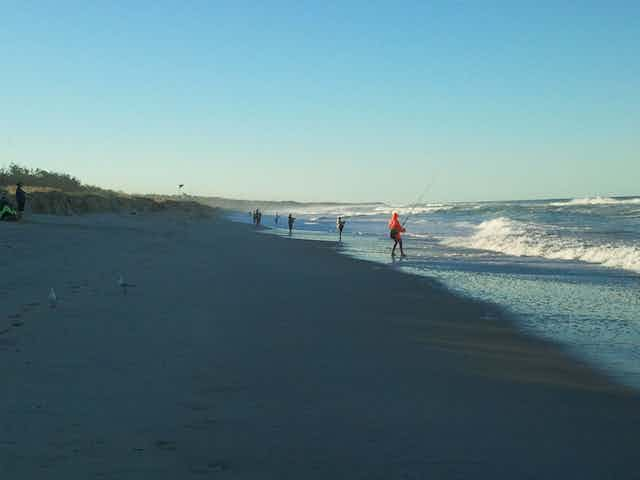The federal government’s recent announcement “reproclaiming” the new Commonwealth Marine Reserves overturns previous plans to protect Australia’s marine biodiversity, and review the management of Australia’s marine parks.
The previous government planned to introduce a limited number of “no-take” marine sanctuary zones, which would exclude commercial and recreational fishing. The new government appears to be arguing that it is possible to allow recreational fishing and still protect biodiversity.
This is a significant opportunity to improve ocean protection in Australia. But calls for a scientific review and yet more consultation are concerning, because there is already a very strong scientific case for highly protected no-take zones. The announcement also appears to ignore the impact that fishing, recreational or otherwise, can have on marine biodiversity, and that marine reserves can improve fishing outcomes.
Buckets of science
What are the benefits of no-take zones? Fortunately scientists have been asking that very question, and there is now plenty of evidence that such zones are vital for protecting our oceans.
Highly protected, no-take marine reserves, also known as marine sanctuaries, increase the diversity, abundance and size of fish around the globe. In Australia, marine sanctuaries also generate significant benefits.

Indeed, the benefits of marine sanctuaries are sufficiently evident that thousands of international scientists have signed multiple consensus statements on the importance of such areas to ocean health as early as 2001 and as recently as 2013 with statements noting their unique role in ecosystem management.
At a time when we see ongoing declines in our fish populations, research demonstrates that no takes marine sanctuaries not only benefit ecosystems, but fisheries too. In the Great Barrier Reef Marine Park, approximately half of commercially and recreationally fished coral trout is produced from no-take marine sanctuaries that represent just 28% of the region.
In other parts of the world, fish abundance increases in areas outside but near to marine sanctuaries, without disadvantaging fishers. The economic value of fisheries can also be greater next to marine sanctuaries.
And recreationally, the best fish are caught on the boundaries of highly protected marine sanctuaries with the non-market value to recreational fishing increasing.
Beyond fisheries benefits, recent research from Tasmania shows that highly protected areas can provide resilience in the face of climate change.
What does all this science say? Put simply if you don’t remove fish from a few places, they become bigger and more abundant. Big fish have disproportionately more offspring, and push smaller fish outside reserves. These two facts create a “spill-over effect” — the effect that should be making recreational and commercial fishers drool with excitement — bigger fish and more fish. And on top of that, the environment is more resilient to change.
Effective fisheries management is essential to healthy oceans; highly protected no-take marine sanctuaries help.
Recreational fishing hurts fish too
The federal government’s announcement mirrors a worrying trend that ignores the impact of recreational fishing.
Recreational fishing — as a component of global catch — is large, growing, and can be both unrecognised and poorly understood with respect to total fish mortality.
We can see this impact in some Australian fish. In Western Australia, both dhufish and herring are considered overexploited, with recreational fishing accounting for about half of the total fishing mortality.
In NSW, mulloway, which is largely taken recreationally, is listed as “overfished”, with the status of recreationally targetted eastern blue groper, pink snapper, flatheads, and morwongs varyingly considered “uncertain”, “fully fished”, or “overfished”. None of these species were assessed as healthy when, earlier this year, the NSW government allowed beach fishers back into state marine sanctuaries.
The romanticised view of recreational fishing as a bloke in a tinny having little impact on fish is inaccurate. It ignores the dramatic increase in fishing power associated with improved recreational fishing technology, increases in recreational boat sizes, and just plain human population growth, trends that are recognised by many recreational fishers.
An opportunity for better marine parks
The federal government has called the previous regulation of marine parks a “lock out” on recreational fishers from vast tracts of ocean. But this is misleading.
Overall, 96% of Australia’s marine environment within 100km of our coast remained open to fishing under the now-defunct commonwealth management plans and existing state plans. The 13.6% of our overall waters afforded a high level of protection were largely offshore and inaccessible to fishers.
At a state level, marine wildlife has even fewer areas of refuge with, for instance, less than 5% of WA and 7% of NSW State waters afforded a high level of protection. These outcomes are well below international benchmarks of protection.
And therein lies the opportunity. The government has stated that “we are protecting the marine reserves but rejecting the flawed plans”.
As we’ve shown, there’s a large body of science demonstrating the benefits of no-take marine sanctuaries, both for conservation and fisheries. To achieve its objective, the government now needs to accept this science, and base new plans on scientific guidelines.
The new management plans, to be released by July next year, should increase the area zoned as no-take marine sanctuaries. These areas also need to be representative of the diversity of our oceans rather than being out-of-sight-and-out-of-mind.
The government must not pander to special interests and avoid dragging the process out as pressure on Australia’s oceans continues to mount. The science is clear: conservation benefits flow from full protection and not partial protection.
Australia has a tremendous opportunity to both protect its own marine biodiversity while making a major contribution to the health and resilience of the world’s oceans. We look forward to the government embracing the science supporting marine sanctuaries and creating a truly world class network of highly protected and representative marine reserves.

